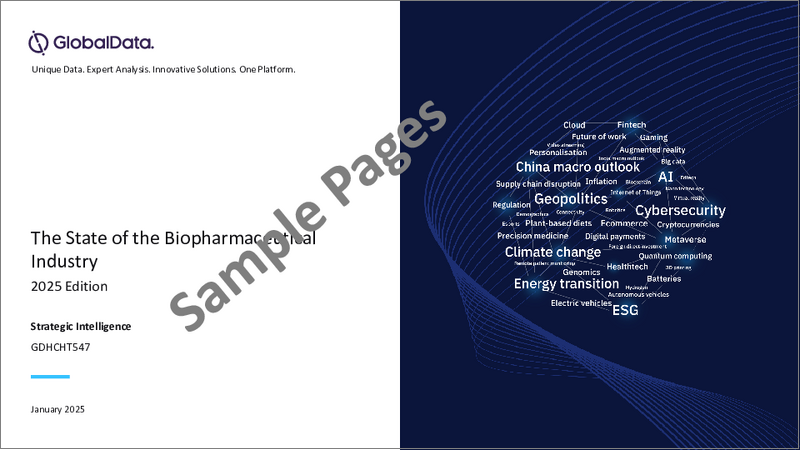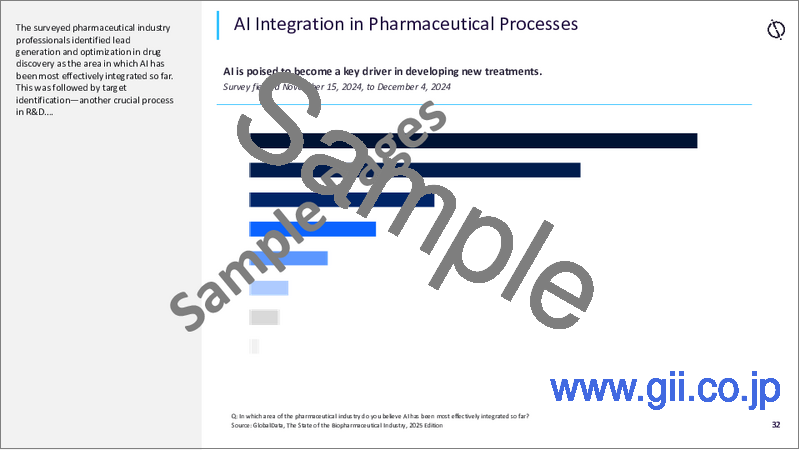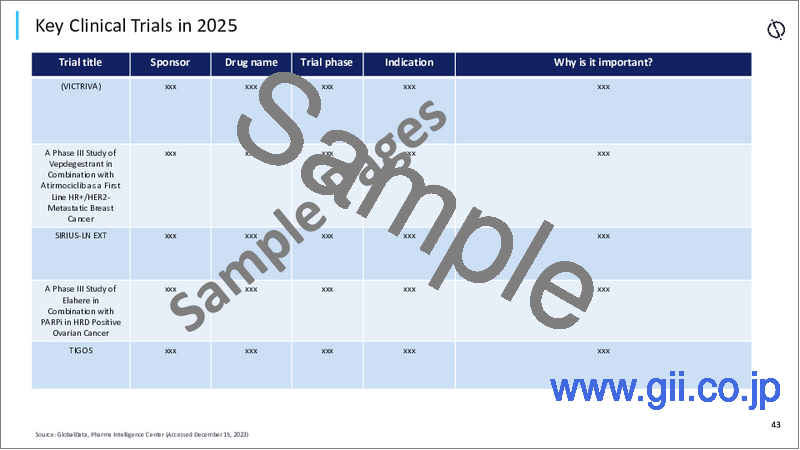|
|
市場調査レポート
商品コード
1646673
バイオ医薬品産業の現状(2025年)- Strategic IntelligenceStrategic Intelligence: The State of the Biopharmaceutical Industry 2025 |
||||||
カスタマイズ可能
適宜更新あり
|
|||||||
| バイオ医薬品産業の現状(2025年)- Strategic Intelligence |
|
出版日: 2025年01月01日
発行: GlobalData
ページ情報: 英文 127 Pages
納期: 即納可能
|
全表示
- 概要
- 目次
さまざまなマクロ経済的・地政学的要因に加え、AIや自動化といった新技術の台頭が、現在のビジネス環境を形成しています。技術の採用は業務や効率化の課題に対する潜在的なソリューションを提供する一方で、企業は依然として需給の不均衡、市場のボラティリティ、地政学的緊張といった問題に直面しています。製薬産業は不況に強いと思われがちですが、将来の課題と無縁ではありません。価格設定と償還(P&R)の制約、進化する規制情勢、バイオセキュア法のような新たな法規制をめぐる不確実性、技術革新やESG問題への対応への圧力といった課題は、今後数年間も製薬産業に課題をもたらし続けます。
主な調査結果
- バイオ医薬品産業は2025年の成長見通しを楽観視していますが、そのレベルは半年前よりも低下しています。
- 2024年のバイオテクノロジーの資金回復について、楽観的または非常に楽観的な見方をする回答者は全体の50%で、半年前のデータから6%減少しました。
- 抗肥満薬、がん免疫療法(IO)薬の開発、臨床試験コストの増加は、今後12ヶ月の産業動向にもっとも影響を与えます。
- 抗肥満薬は、2025年にもっとも大きな影響を与える新たな製薬産業の動向として特定されました。
- マクロ規制動向では、ブロックバスター医薬品のライフサイクルマネジメント(LCM)と生物製剤の特許満了が製薬産業にもっとも大きな好影響を与えると予測されます。
- 価格設定と償還の制約と地政学的紛争は、バイオ医薬品部門の成長にとっての主な障害となります。
- 製薬産業の専門家は、政策が不透明な中、米国の大統領の移行をむしろ懸念しています。
- ビッグデータとAIは、今後1年以内に医療部門を変革する力として優位にあり続ける見通しです。
- AIは、新治療法をより速いペースで開発し、費用対効果を高める重要な促進要因となります。
- 嚢胞性線維症治療薬、Vanzacaftor calcium + deutivacaftor + tezacaftorは、2025年に上市する中でもっとも高い商業的成功を収めると予測されます。
- 2025年に臨床試験が開始される領域は、がん、中枢神経系(CNS)、心血管が支配的です。
- がんは2025年に治療の主流を占めますが、もっとも高い成長を示すのは皮膚科です。
当レポートでは、世界のバイオ医薬品産業について調査分析し、2025年に影響を与える新技術、業界動向、規制動向、マクロ経済要因などの情報を提供しています。
目次
第1章 エグゼクティブサマリー
第2章 調査の設計
- 目的と設計
- 回答者の構成
第3章 新たな産業動向
- もっとも影響力のある新興産業の動向
- 肥満治療薬が製薬産業に影響を与える動向のトップに
- 競合が激しい肥満治療法の開発の分野
- 医薬品バリューチェーンに影響を与える新技術
- AIは医薬品バリューチェーンにプラスの影響を与えると予測される
- AIは主に新薬の発見と開発の初期段階で利用されている
- 近年の複数の挫折にもかかわらず、がん免疫療法は成長を続けている
- がん免疫療法薬:近年の承認と上市
- 個別化/精密医療:治療成果を向上させる選択肢
- 個別化/精密医療:近年の承認と上市
- リアルワールドエビデンスは製薬産業にとって価値ある必須の情報源になりつつある
- リアルワールドエビデンス臨床試験の増加
- 医薬品の需要の増加はサプライチェーンの課題につながる第一の理由である
- 臨床試験の複雑性とコストの上昇が医薬品開発に影響を与える
- 臨床試験の複雑性とコストの上昇
- 細胞・遺伝子治療は主に血液悪性腫瘍に焦点を当てている
- 細胞・遺伝子治療のアプローチはがんを超えて拡大している
- 細胞・遺伝子治療市場は今後数年間で大幅に成長すると予測される
- バイオシミラーの普及は市場や疾患によって異なる
- 主なバイオシミラーの近年の承認は、医薬品市場に対する普及に影響を与える可能性がある
- 抗体薬物複合体
- 抗体薬物複合体の初期段階の成熟がADC市場の将来の拡大の鍵となる
- 分散型/仮想臨床試験
- 分散型/仮想臨床試験をサポートするツールと技術
- 臨床試験における分散型/仮想コンポーネントの利用はパンデミック後も安定している
- マイクロバイオーム医薬品開発
第4章 新たな規制とマクロ経済の動向
- 新たな規制とマクロ経済のプラスとマイナスの動向
- 新たな規制とマクロ経済の動向
- 地政学的紛争は継続的な懸念として残る
- 地政学的リスクの概要
- 価格設定と償還の動向
- 2024年のP&R政策イベントが市場参入に影響を与えると予測される
- 主要市場におけるP&Rの見通しの変化の主な要因
- 米国の政治的分裂と2024年の米国選挙
- 米国外に対する影響:EUの政策立案者が関税の影響を評価
- トランプ大統領の製薬産業に対する影響
- 価格設定と償還の動向
- 新たな規制とマクロ経済の動向に関する回答者の意見 - 否定的
- 新たな規制とマクロ経済の動向
- 新たな規制とマクロ経済の動向:地域別
- 生物製剤の特許切れに関する回答者の意見
- 生物学的製剤の特許切れとバイオシミラー
- バイオシミラーの価格
- ブロックバスター医薬品のライフサイクル管理
- 製造と医薬品の不足
- 商業用注射剤の契約製造の動向
- 新たな規制とマクロ経済の動向に関する回答者の意見 - 肯定的
第5章 政策と規制
- インフレ抑制法
- インフレ抑制法の実施スケジュール
- インフレ抑制法:交渉対象となる最初の製品
- EU医薬品改革
- 新たなIRP回廊とEU内での上市戦略の変更
- EU医薬品改革
- バイオセキュア法
第6章 新技術
- もっとも影響力のある新技術
- もっとも影響力のある新技術 - 過去のデータ
- AIが製薬産業に影響を与える技術をリード
- 医薬品プロセスにおけるAIの統合
- R&Dの生産性向上に対するAIの影響
- 生産性を高めコストを削減するAI
- AIとビッグデータに関する回答者の視点
第7章 産業の成長見通し
- 産業に対する見解
- 産業の成長に対する楽観
- 今後12ヶ月間の産業の成長に関する回答者の見解
第8章 注意点
- 製薬産業における革新への圧力
- イノベーションパイプラインに関する回答者の視点
- がんにおける安全かつ効果的な標的治療に向けた放射性医薬品の登場
- 放射線治療の市場可能性
- mRNAワクチン
- mRNAワクチン - 感染症
- バイオテクノロジー資金の減少と回復
- バイオ医薬品資金の回収
- 株式市場の回復
- 政府助成金 - バイオテクノロジーの代替資金源となるか
- 臨床試験の早期プレビューは2025年に開始
- 主な臨床試験(2025年)
- 2025年に開始される臨床試験
- 2025年に予定される試験の完了
- 売上上位10の医薬品(2024年・2025年)
- 医薬品売上上位10の治療分野と予測(2024年・2025年)
- 2025年に予定される新薬の上市
- カタリスト - Vertex Pharmaceuticals
- カタリスト - GSK
- カタリスト - AstraZeneca/Daiichi Sankyo
第9章 主な調査結果のサマリー
- 主な調査結果
第10章 付録
第11章 著者と寄稿者
第12章 お問い合わせ
A range of macroeconomic and geopolitical factors, along with the rise of emerging technologies, such as AI and automation, are shaping the current business landscape. While adoption of technologies can offer potential solutions to operational and efficiency challenges, businesses still face issues such as supply-demand imbalance, market volatility, and geopolitical tensions. Although the pharmaceutical industry is often considered as recession-resistant, it is not immune to future challenges. Factors such as constraints on drug pricing and reimbursement (P&R), the evolving regulatory landscape, uncertainties surrounding new legislations such as the BIOSECURE Act, and pressures to innovate and to address environmental, social, and governance (ESG) issues will continue to pose challenges for the pharmaceutical sector in the coming years.
In this The State of the Biopharmaceutical Industry report, GlobalData examines the business environment, challenges and trends that are going to impact the biopharmaceutical industry in 2025. The report highlights the most impactful emerging technologies, industry trends, regulatory trends, and macroeconomic factors that are going to impact and dominate the industry throughout the next 12 months
Key findings include -
- The biopharmaceutical industry is optimistic about its growth prospects in 2025, but the levels of optimism are lower than six months ago.
- A total of 50% of survey respondents shared optimistic or very optimistic sentiment on biotech funding recovery in 2024, down by 6% from the data obtained six months ago.
- Anti-obesity medications, immuno-oncology (IO) drug development, and increasing costs of clinical trials will be among the most impactful industry trends for the next 12 months.
- Anti-obesity medications were identified as the emerging pharmaceutical industry trend to have the greatest impact for 2025.
- From macro and regulatory trends, lifecycle management (LCM) of blockbuster drugs and patent expiration of biologics are expected to have the greatest positive impact on the pharmaceutical industry.
- Drug pricing and reimbursement constraints and geopolitical conflicts will be the main hindrances for the biopharmaceutical sector growth.
- Pharmaceutical industry professionals are rather concerned about the US presidential transition amid policy uncertainty.
- Big data and artificial intelligence (AI) will continue to dominate as transformational forces in the healthcare sector in the next 12 months.
- AI is poised to become a key driver in developing new treatments at a faster pace and with increased cost-effectiveness.
- Vanzacaftor calcium + deutivacaftor + tezacaftor for cystic fibrosis is expected to have the highest commercial success among the 2025 launches.
- Oncology, central nervous system (CNS), and cardiovascular are the dominant areas for clinical trials to be initiated in 2025.
- Oncology will dominate the therapy landscape in 2025, but dermatology will display the highest growth.
Scope
Benchmark the impact of major themes on the biopharmaceutical industry in the next 12 months, including -
- Emerging technologies
- Regulatory trends
- Macroeconomic trends
- Industry trends
- Identify themes that will have the greatest positive or negative impact in the next 12 months.
- Capture opinions on these themes from industry experts.
- Predict the industry's growth prospects in the next 12 months.
Reasons to Buy
- Understand the business environment and the industry, regulatory, and macroeconomic trends that are going to shape the biopharmaceutical industry in the next 12 months.
- Benchmark the impact of major themes on the biopharmaceutical industry in the next 12 months,
- Identify themes that will have the greatest positive or negative impact in the coming months.
- Comprehend the opinions of industry respondents on these themes.
- Predict the industry's growth prospects in the next 12 months.
Table of Contents
Table of Contents
1. Executive Summary
2. Study Design
- 2.1. Objectives and Design
- 2.2. Respondent Mix
3. Emerging Industry Trends
- 3.1. The Most Impactful Emerging Industry Trends
- 3.2. Anti-obesity Medications Top the Trends Impacting the Pharmaceutical Industry
- 3.3. Highly Crowded Field of Anti-obesity Medications in Development
- 3.4. Emerging Technologies Impacting the Pharmaceutical Value Chain
- 3.5. Artificial Intelligence is Expected to Have a Positive Impact on the in Pharmaceutical Value Chain
- 3.6. AI is Predominantly Used in the Early Stages of Drug Discovery and Development
- 3.7. Immuno-oncology Continues to Show Growth in Oncology, Despite Some Recent Setbacks
- 3.8. Immuno-oncology Drugs: Recent Approvals and Launches
- 3.9. Personalized/Precision Medicine: an Option for Improving Treatment Outcomes
- 3.10. Personalized/Precision Medicine Drugs: Recent Approvals and Launches
- 3.11. Real-World Evidence is Becoming a Valuable and Necessary Source for the Pharmaceutical Industry
- 3.12. Increase in Real-Word Evidence Clinical Trials
- 3.13. Increased Demand for Drugs Tops the Reasons Leading to Supply Chain Challenges
- 3.14. Complexity and Rising Costs of Clinical Trials Impact Drug Development
- 3.15. Complexity and Rising Costs of Clinical Trials
- 3.16. Cell and Gene Therapies Are Primarily Focused on Hematological Malignancies
- 3.17. Cell and Gene Therapy Approaches are Expanding Beyond Oncology
- 3.18. Cell and Gene Therapy Markets are Expected to Grow Significantly in Coming Years
- 3.19. Biosimilars Uptake Varies Across Markets and Diseases
- 3.20. Recent Approvals of Key Biosimilars May Impact Their Uptake in the Pharma Markets
- 3.21. Antibody-Drug Conjugates
- 3.22. Successful Maturation of Early-Stage Antibody-Drug Conjugates is Key for Projected Increase in ADC Market
- 3.23. Decentralized/Virtual Clinical Trials
- 3.24. Tools and Technologies Supporting Decentralized/Virtual Clinical Trials
- 3.25. Utilization of Decentralized/Virtual Components in Clinical Trials Remains Steady Post-Pandemic
- 3.26. Microbiome Drug Development
4. Emerging Regulatory and Macroeconomic Trends
- 4.1. Top Positive and Negative Emerging Regulatory and Macroeconomic Trends
- 4.2. Emerging Regulatory and Macroeconomic Trends
- 4.3. Geopolitical Conflicts Persist as an Ongoing Concern
- 4.4. Geopolitical Risk Summary
- 4.5. Pricing and Reimbursement Trends
- 4.6. P&R Policy Events in 2024 Expected to Affect Market Access
- 4.7. Key Drivers of Changes to P&R Outlook in Major Markets
- 4.8. Political Divide in the US and US Elections 2024
- 4.9. Implications Outside the US: EU Policymakers Assess Impact of Tariffs
- 4.10. Trump Presidency's Impact on Pharma
- 4.11. Pricing and Reimbursement Trends
- 4.12. Respondents Opinion on Emerging Regulatory and Macroeconomic Trends - Negatives
- 4.13. Emerging Regulatory and Macroeconomic Trends
- 4.14. Emerging Regulatory and Macroeconomic Trends - By Geography
- 4.15. Respondents' Opinion on Patent Expiration of Biologics
- 4.16. Biologic Patent Expiration and Biosimilars
- 4.17. Biosimilar Pricing
- 4.18. Lifecycle Management of Blockbuster Drugs
- 4.17. Manufacturing and Drug Shortages
- 4.18. Commercial Injectable Contract Manufacturing Trends
- 4.19. Respondents' Opinion on Emerging Regulatory and Macroeconomic Trends - Positives
5. Policies and Regulations
- 5.1. Inflation Reduction Act
- 5.2. Inflation Reduction Act Implementation Timeline
- 5.3. Inflation Reduction Act: First Products Subject to Negotiation
- 5.4. EU Pharmaceutical Reform
- 5.5. New IRP Corridors and Changes in Launch Strategies Inside EU
- 5.6. EU Pharmaceutical Reform
- 5.7. BIOSECURE Act
6. Emerging Technologies
- 6.1. Most Impactful Emerging Technologies
- 6.2. Most Impactful Emerging Technologies - Historical Data
- 6.3. AI Leads the Technologies Impacting Pharmaceutical Industry
- 6.4. AI Integration in Pharmaceutical Process
- 6.5. AI's Impact on Improving R&D Productivity
- 6.6. AI to Enhance Productivity and Lower the Costs
- 6.7. Respondents' Perspective on AI and Big Data
7. Industry's Growth Prospects
- 7.1. View on Industry's
- 7.2. Optimism for the Industry's Growth
- 7.3. Respondents' Perspective on Industry's Growth During the Next 12 Months
8. Watch Outs
- 8.1. Pressure to Innovate in the Pharma Sector
- 8.2. Respondents' Perspective on Innovation Pipeline
- 8.3. Emergence of Radiopharmaceuticals for Safe and Effective Targeted Treatment in Oncology
- 8.4. Market Potential for Radiotherapeutics
- 8.5. mRNA Vaccines
- 8.6. mRNA Vaccines - Infectious Diseases
- 8.7. Downturn and Recovery of Biotech Funding
- 8.8. Recovery of Biopharmaceutical Funding
- 8.9. Upturn in Public Markets
- 8.10. Government Grants - An Alternative Source of Biotech Funding?
- 8.11. An Early Preview of Clinical Trial Starts in 2025
- 8.12. Key Clinical Trials in 2025
- 8.13. Clinical Trials Anticipated to Initiate in 2025
- 8.14. Projected Trial Completion in 2025
- 8.15. Top 10 Selling Drugs - 2024 Versus 2025
- 8.16. Top 10 Therapy Areas for Drug Sales and Forecast - 2024 vs. 2025
- 8.17. Drug Launches Expected in 2025
- 8.18. Catalysts - Vertex Pharmaceuticals
- 8.19. Catalysts - GSK
- 8.20. Catalysts - AstraZeneca/Daiichi Sankyo
9. Summary of Key Findings
- 9.1. Key Findings
10. Appendix
- 10.1. Abbreviations
- 10.2. Related Reports
11. Authors and Contributors
- 11.1. Authors
- 11.2. Contributors
12. Contact Us
- 12.1. Contact Us
- 12.2. About GlobalData
- 12.3. A Connected Platform for a Dynamic World






